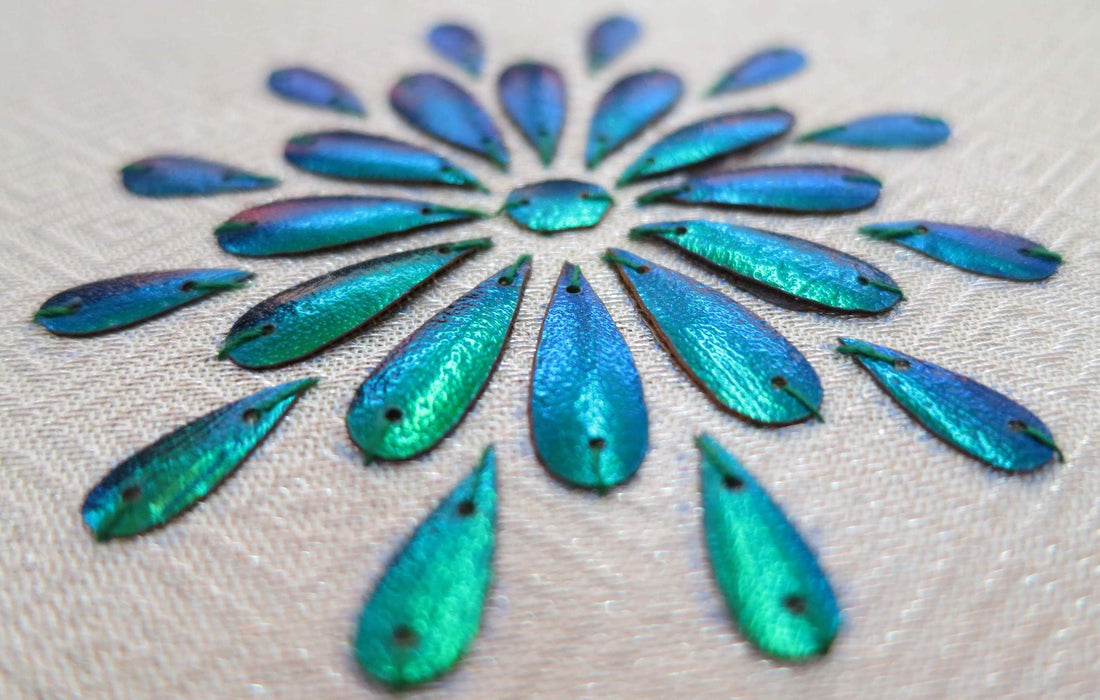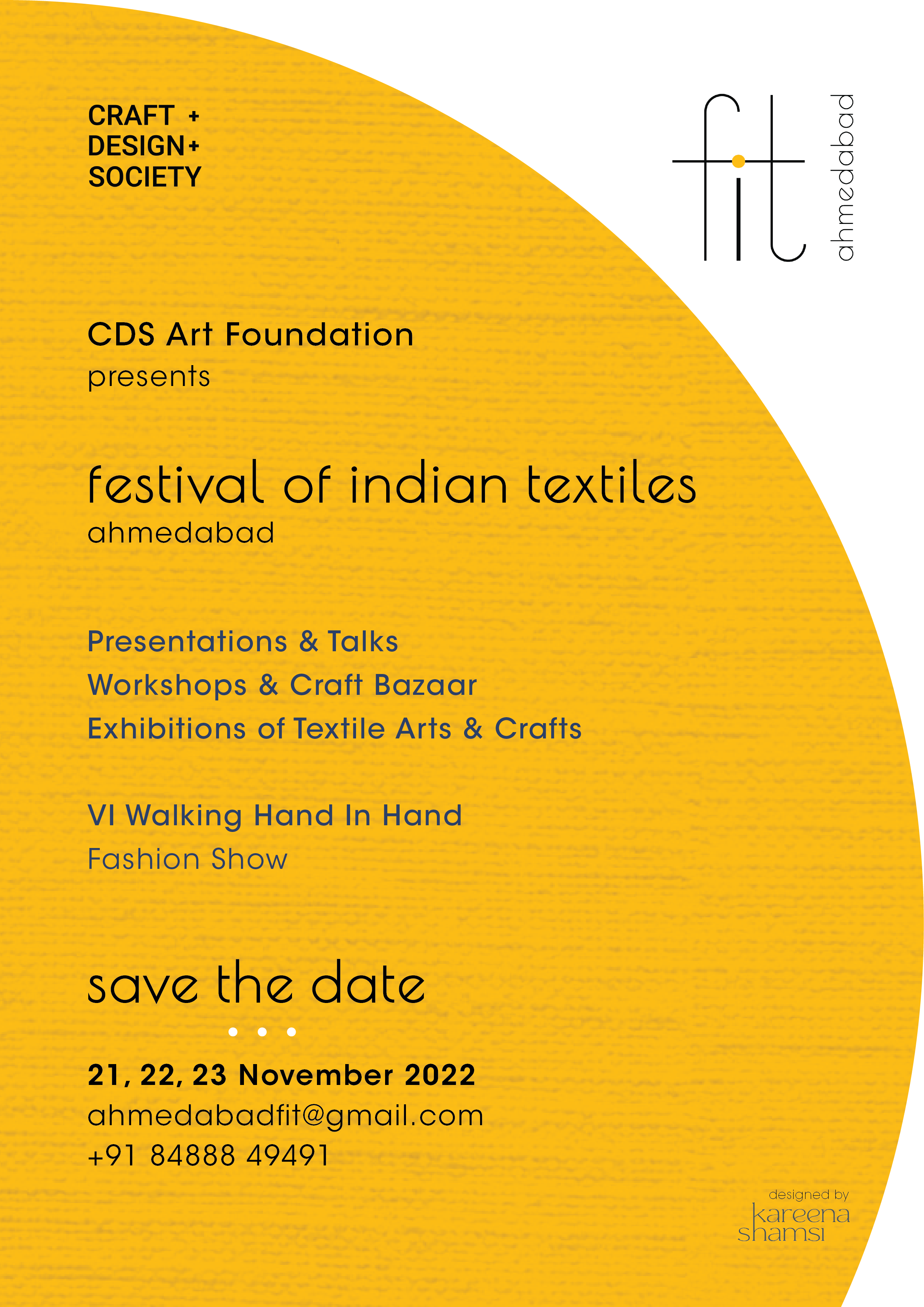
JEWEL TONES OF ELYTRA EMBROIDERY
Images Courtesy: Asif Shaikh
By Brinda Gill
Master embroiderer Asif Shaikh finds deep fulfilment in creating embroideries with beetle-wing casings
“I believe beetle-wing casings are a gift from nature. The casings are strong, slightly curved and of beautiful glossy green colour that often shifts to turquoise blue, purple and copper on changing their angle or one’s own viewing angle. I thoroughly enjoy using them in embroidery to create works of art and garments that are like wearable art. We are truly fortunate to have access to these gifts of nature”, says master embroiderer Asif Shaikh, Ahmedabad, Gujarat, India, as he traces his journey of working with this lesser-known element.
Asif elaborates. “Beetle-wing casings are collected from dead beetles native to forests in northern Thailand. The beetles have a short lifespan. They are collected after they die and then the casings of their wings are harvested. In some places the beetles are eaten as they are a good source of protein and the casings are removed in the process. So the casings not obtained by killing the insects for embroidery work. They are like a by-product that gets a new lease of life in embroidered works. In fact, I believe these embroideries celebrate and preserve their natural beauty. As the casings are durable, textiles and objects adorned with them could last for centuries if they are well-preserved”.  Images Courtesy: Asif Shaikh
Images Courtesy: Asif Shaikh
Beetle-Wing Casings
The beetle-wing casings, also known as elytra, are the rigid forewings (not the actual wings) of jewel beetles that are admired for their eye-catching metallic hues. The family of jewel beetles, spanning a spectrum of beetles, have long fascinated naturalists for the iridescent beauty of their wing casings. These have also been valued by artisans who have used the casings to embellish garments, jewellery, artefacts and accessories.
The craft of affixing beetle-wing casings has been prevalent in Asian countries for several centuries. Exquisite beetle-wing casings, embroidered garments, ornaments and accessories were handcrafted in India in centuries past. As casings are durable they have lasted long, especially on well-preserved antique museum textiles, jewellery and objects on which they retain their glossy sheen.
Into the present, for embroidery, beetle-wing casings are used in their natural shape, slightly shaped or cut into round or square sequins. These casings are then stitched onto cloth by making stitches through tiny perforations made in the casings as well as by stitches over and along their edges (similar to how mirrors are affixed on cloth) that is without making holes in the casings.  Image: Beetle Wings and Ruby on Brocade Fabric. Image Courtesy: Asif Shaikh
Image: Beetle Wings and Ruby on Brocade Fabric. Image Courtesy: Asif Shaikh
Creating A Sample
Asif had seen textiles and garments with beetle-wing embroidery in museums in India and abroad, and in textile books featuring a range of Indian and Western garments as well as jewellery, artefacts and accessories embellished with beetle wing casings. Western garments, of fine cotton muslins, were adorned with beetle casings, often in lovely floral motifs, for British patrons when India was under the rule of the East India Company (1757-1858) and the British Crown (1858-1947).
Asif had looked for beetle wing casings in markets including Chatuchak Market during his travels to Bangkok, Thailand; however he could not find them. While attending the International Innovative Craft Fair 2014 in Bangkok he unexpectedly saw an embroiderer stitching beetle-wing casings on a fabric, and had a close-up view of the scintillating beauty of the metallic wings, their touch and feel, their smooth curved surfaces that caught and reflected light in different colours. He was fascinated by their shifting shiny colours and inherent strength even as they were fragile. As the embroiderer and he spoke about their shared love for hand-embroidery and about beetle-wing embroidery, he requested her for casings and bought a pack of a hundred casings from her.
Their beauty played in his mind, and he returned to his studio in Ahmedabad keen to work with them. “Each beetle-wing is of a slightly different size and shape, so it requires a little time to think of how they can be worked in a design. With beetle-wing embroidery one has to visualise the design and then cut the wings. The placement of the wings on the design has to be checked before starting the embroidery to get the best shine of each wing”.  Image Courtesy: Asif Shaikh
Image Courtesy: Asif Shaikh
Deciding to make a sample first, Asif created a butter paper-design of a simple flower with a round centre encircled by petals in three layers of slightly different sizes. The casings were then cut true to the form of the paper-design with a laser cutter to obtain neat, uniform shapes matching the paper design.
Asif selected the thinnest embroidery needle, measured its thickness and made one tiny perforation at the two ends of each casing (with the laser cutter) of the needle’s thickness (so that the thinnest needle could go through the casing and very fine stitches could be made). He took care that the perforation was not too close to the edge of the casing otherwise it may crack.
The fabric was then stretched on a wooden frame ensuring just the correct tension for the embroidery. The paper design, itself pierced with a needle to create perforations along its lines, was then placed on silk brocade fabric, and powder rubbed over it to transfer the design on cloth. The cut casings were then placed on the cloth to reconfirm their form.
One by one the casings were affixed with fine stitches with the needle piercing the casing and cloth through the perforation and then each casing was couched, along its edge, with 8-ply gold-plated silver thread. The entire process gave Asif a first-hand understanding of working with beetle-wing casings, and as the sample was completed the flower shone like an emerald-encrusted ornament.
A New Dimension
Asif returned to the International Innovative Craft Fair 2015 with the embroidered sample and it was much appreciated for its beauty and fineness. “Dr. Anucha Thirakanont, Dean of the Faculty of Fine and Applied Arts, Thammasat University, a textile expert, remarked that he had never seen such beautiful embroidery with beetle casings. He most kindly arranged two kilograms of beetle casings to be sent for me. That was about 20,000 casings!”
Delighted to receive the consignment, Asif felt he needed to explore the potential of the casings and elevate their expression in embroidery. As he kept thinking of possibilities, he chanced upon a textile woven with fine barbs of peacock feathers at Benares, one of India’s most famed traditional weaving centres.
“Something just clicked when I saw and held the fabric woven with supplementary peacock feathers. It had a character, texture, a slight sheen and thickness. Like beetle-wings embroidery, I felt this fabric incorporated elements of nature that had been naturally discarded by a creature as peacocks naturally shed their beautiful features. Seeing the cloth, I knew I had found the perfect fabric to embroider beetle-wing casings”.
Back at his studio Asif first created textile art works of flowering plants designed with a central stem from which symmetrical branches emerge bearing leaves and flowers. The glistening green casings were placed as leaves and to complement their jewel-like look Asif decided to stitch rubies as flower petals! To allow the green of the casings to be the highlight, Asif did not use emeralds.
The peacock-feather fabric was carefully stretched on the frame and the design transferred on it; this was a challenge as the fabric has a feathery texture, yet with his knowledge and practise of embroidery he could work it out. Both elements (the casings and rubies) had thin holes and were stitched on the cloth with fine couching with 8ply gold-plated silver thread. The same thread was used for the stem and a few leaves to create a harmonious composition of glistening beetle-wing casings, rubies and gold thread. 
Image: Peacock feather woven fabric. Image Courtesy: Asif Shaikh
A Masterpiece
Deeply satisfied and happy with the embroidered work Asif continued his work with casings and decided to create an art work of a glorious Tree of Life. Expanding on the earlier flowering plant designs, he sketched a large Tree of Life (22” by 29”); it was a symmetrical composition with a central stem with multiple branches bearing bunches of flowers and buds. The tree was set in a rectangular frame with a border of a flowering vine between straight lines of casings and curving vines in the spandrels of the frame.
The flowers, buds and leaves were brought alive with casings (cut round like sequins and petal shaped), and gold-plated silver thread couching and stitches; a total of 2000 casings were used for the work. After the casings were stitched, Asif lifted the frame to view the work in the mirror in a darkened room. He was mesmerised by the effect of a range of metallic colours and tones of the casings that appeared like live beetles in flight at night.
On completion the work dazzled viewers and brought to mind the formal, perfect courtly crafts patronised by erstwhile princely states of India. “The Tree of Life work was displayed at Pohon Budi-Tree of Life Exhibition, at Galeri Petronas, Kuala Lumpur in November 2015. The exhibition featured more than 200 works on the theme of the tree of life motif in different cultures. The exhibition was inaugurated by Her Royal Highness DYMM Sultanah Terengganu, Sultanah Nur Zahirah, and she was very appreciative of the work. She said it was the first time she had seen such beautiful beetle wing casings embroidery. The work was displayed at Old Court House, Kuching, in February 2016 where it was appreciated”. 
Image: Tree of Life, Asif Shaikh Embroidery, Beetlewings on Peacock feather woven fabric. Image Courtesy: Asif Shaikh
“Beetle wing embroidery is one of the high arts of embroidery for its beauty as well as the skill required to create fine works. The embroiderer has to shape and stitch the casings carefully so they are not damaged. The design and stitches should be created in a way that allows the casings to be the focus of the work and only add to their beauty subtly. I have embroidered beetle wings on textile art and silk brocade garments, one of which was showcased at the Second Walking Hand-in-Hand fashion show of CDS Art Foundation at Ahmedabad in 2016. Friends in Thailand thoughtfully collect casings and send them to me! I am happy to have revived one of India’s most glorious embroidery techniques whose beauty has a universal appeal. I am truly grateful for nature having given us these elements to create these spectacular artworks and garments”. 
Image: Tree of Life. Image Courtesy: Asif Shaikh
In November 2022, Asif Shaikh completes thirty years of formally working with Indian textiles and embroidery. Towards this special occasion he has announced the Festival of Indian Textiles, Ahmedabad, India, hosted by CDS Art Foundation on 21- 23 November 2022.
The highlight of the festival will be the 6th Walking Hand-in-Hand on 22 November, a spectacular fashion show of exclusive handcrafted garments.
Asif will be showcasing a special collection of thirty garments that encapsulate thirty years of his work in embroidery. Among them is a drape, of 300 count hand-spun hand-woven undyed muslin embroidered with 7000 sequins cut from beetle wing casings. The design of the embroidery features small motifs in the field and borders. The drape will be worn with a garment inspired by a European gown.
